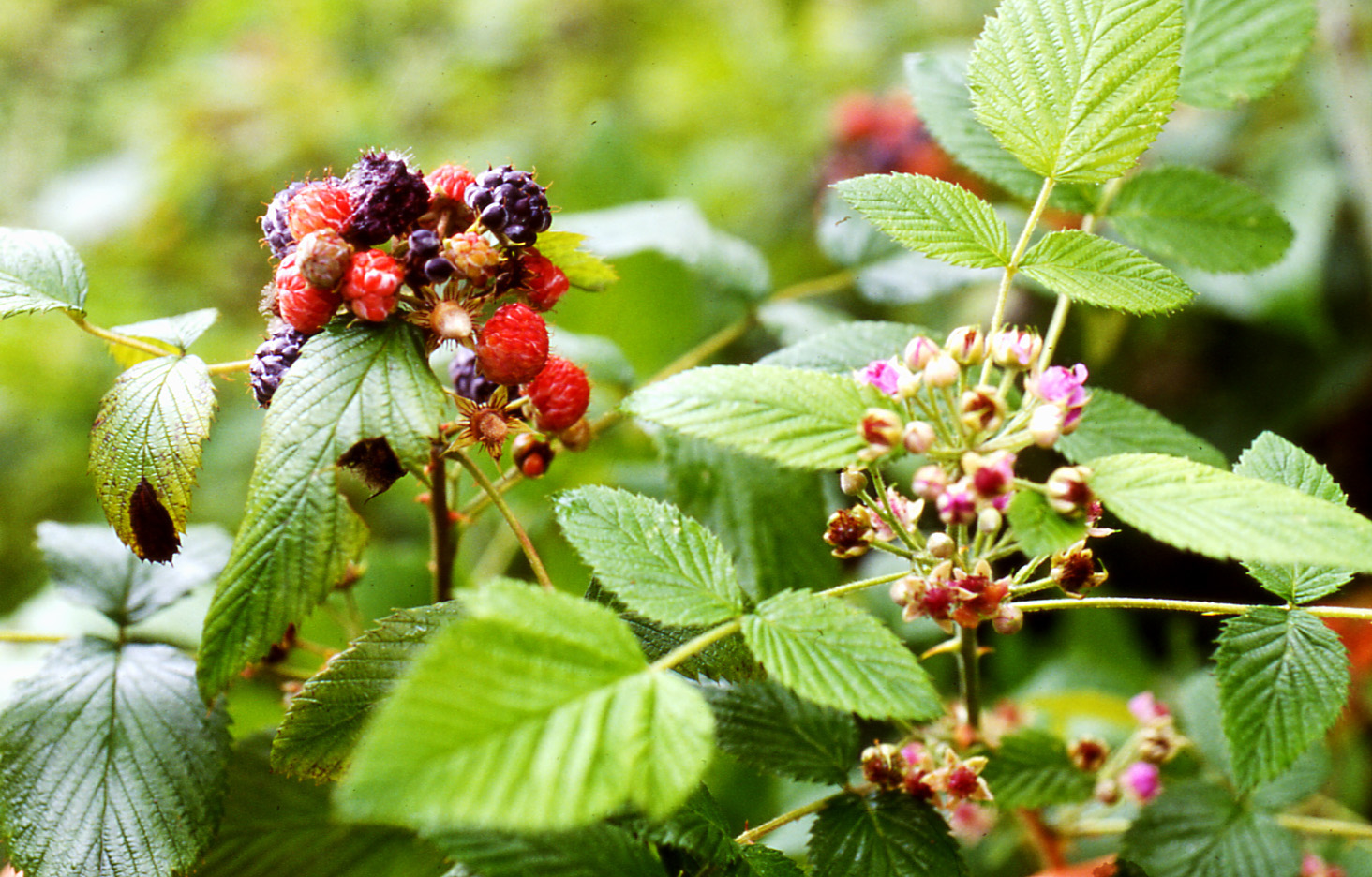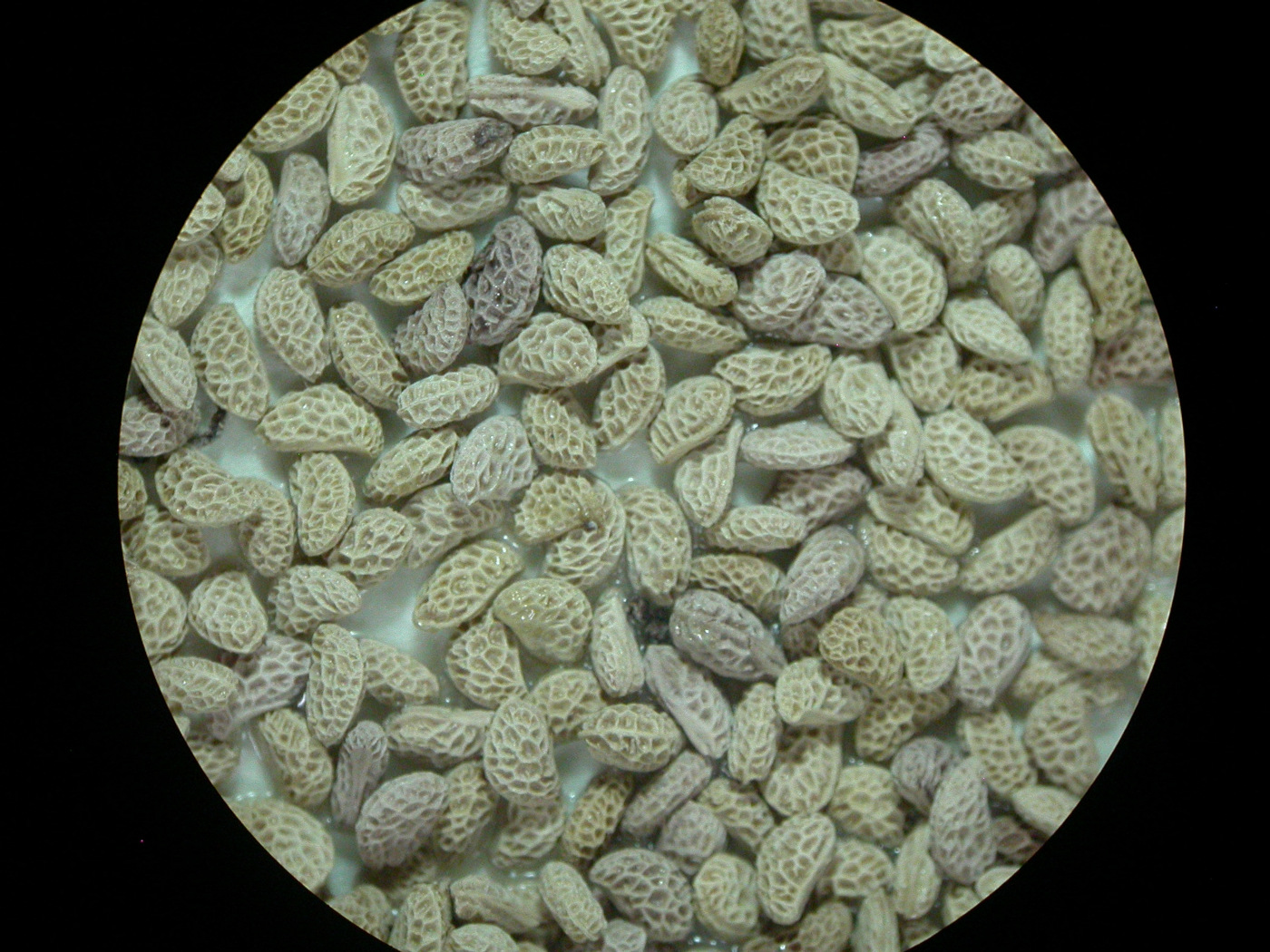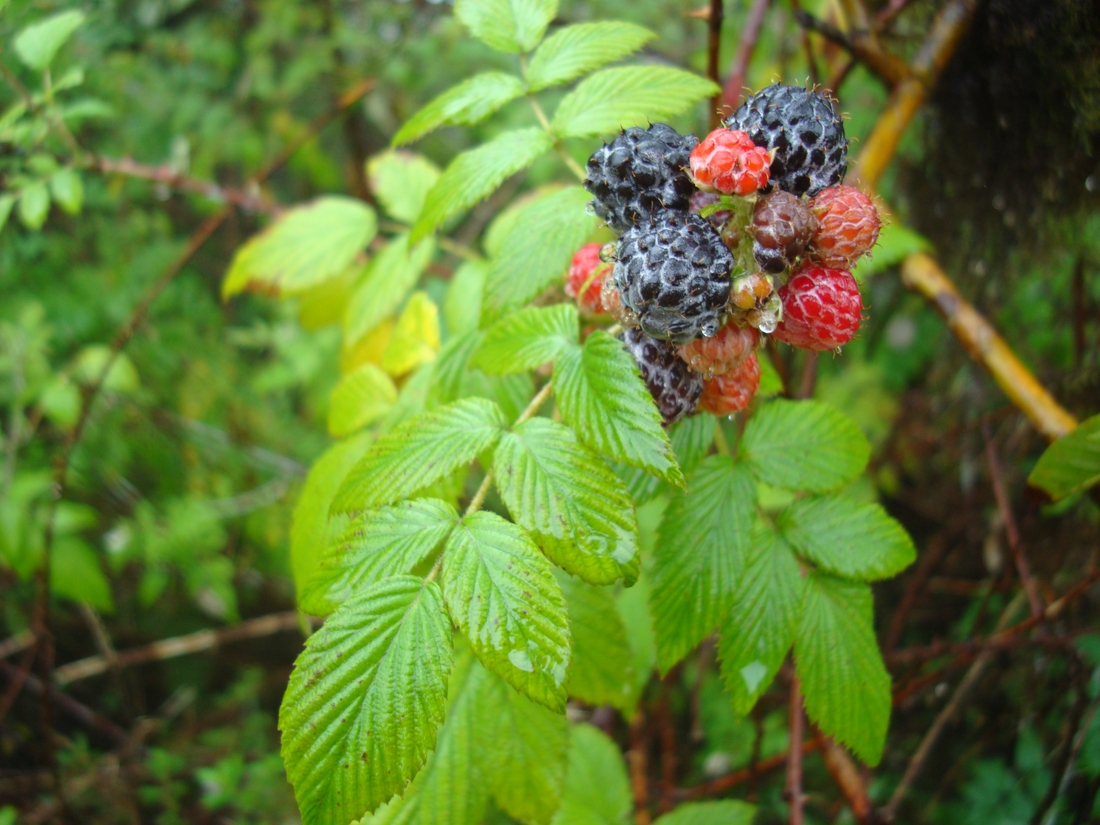Galapagos Species Database
The Galapagos Species Database shares the information about the species from our Natural History Collections.
Rubus niveus
mora, mora de Castilla, mora de monte, mora extranjera, mora silvestre o morita, Blackberry, hill raspberry, Ceylon raspberry








A climbing perennial shrub that can grow to a height of 5m and under all light conditions. The stems are smooth and spiny with a whitish sheen. The green leaves have 7 to 10 leaflets with a whitish fur on the underside. The pink flowers occur in groups of 20-50. Fruit look like blackberries, sweet to taste, purple and furry. The plant grows quickly and produces flowers and fruits from 6 months of age. The fruits are dispered by animals, and the seeds remain viable in the soil for at least 4 years. It can also spread by suckers.
There are four other species of Rubus introduced to Galapagos, however, this is the only one that has spread.
Domain
Eukaryota
Kingdom
Plantae
Phylum
Magnoliophyta
Class
Magnoliopsida (= Dicotyledoneae)
Order
Rosales
Family
Rosaceae
Genus
Rubus
Species
niveus
Taxon category: Accepted
Syn. over 20 names, including Rubus albescens Roxb.; Rubus lasiocarpus Sm.
Taxon origin: Introduced - established
Preference for an altitude zone in Galapagos: Humid zone
Habitat preferences: Prefers moist to wet areas. Found in forest edges, riparian habitats, woodland, and disturbed sites.
Trophic role: Primary producer
Persistence mechanisms: Seeds
Reproductive biology: Fruit is dispersed by animals, especially birds. The seeds remain viable in soil for at least 4 years. The plant is also able to spread vegetatively, producing roots when its long branches touch the ground.
Growth form: Shrubs
Distribution origin: Introduced from India via South Africa and Central America to Ecuador. Introduced several times to Santa Cruz island, Galapagos for its fruit, starting in 1968, and from there to the other islands.
Distribution classification: Paleotemperate
Economic Use: Introduced for its fruit. Fruit still used for jams.
Mode of introduction: Intentional
Introduction Pathway: Intentional
Subpathway: Agriculture/Horticulture
Introduced status: Naturalized
Invasive status: Invasive
Impact in Galapagos: In Galapagos, Rubus niveus has invaded open vegetation, shrubs and forests, forming dense patches up to 4 m high, replacing native vegetation and threatening many native communities such as Scalesia pedunculata forest. In the agricultural zone, R. niveus has spread aggressively, making land unsuitable for agriculture, and causing serious economic problems for farmers.
Impact elsewhere: Known problem in Hawaii for agriculture.
Control History in Galapagos: Seedlings can be pulled by hand. The use of herbicide (picloram) on leaves can kill the plants. Due to its extent in Galapagos, cover, a seed bank that lasts about 4 years, and the rapid growth of plants from seedling to reproduction, manual and chemical control is complicated. This species would be as ideal target for biological control.
Control methods elsewhere: In Hawaii a herbicide cocktail is used consisting of Garlon 4, Roundup Promax and Escort XP or, Milestone VM Plus.
Known Pest elsewhere: Southern Africa, Central and Southern America, Hawaii, Australia
Year of first record: 1968
Year of introduction: 1968
Map of specimen collection localities or observation records for this species in our collections database.
Distribution: Santa Cruz, San Cristobal, Isabela, Floreana, Santiago. The distribution on Santa Cruz and San Cristobal is broad and affects the agricultural area and National Park on both islands. The distribution on Isabela, Floreana, and Santiago is smaller but it is expanding rapidly.
- Lawesson, J.E. (s.a.) Pers. obs. field notes, collections 1985-7.
- Prado, L. et al. (1995) Informes de salida al campo, abril y mayo de 1995, Isla Isabela, Investigacion agroforestal. Charles Darwin Research Station, unpublished, Archivos de Botanica.
- Moll, E. (1990) A Report on the Distribution of Introduced Plants on Santa Cruz Island, Galapagos Charles Darwin Reaearch Station, unpublished.
- Tropicos.org. (2017) Database of Missouri Botanical Garden. Tropicos.org. Missouri Botanical Garden. 06 Oct 2017 <http://www.tropicos.org
- Chen, J. Craven, L.A. (2007) Flora of China. Flora of China 13: 321–328. http://www.efloras.org/florataxon.aspx?flora_id=2&taxon_id=10599
- Stevens, W.D. Ulloa, C., Pool, A., & Montiel, O.M. (2001) Flora de Nicaragua. Monogr. Syst. Bot. Missouri Bot. Gard. 85: i–xlii, 1–2666.
- Pankhurst, R.J. (2001) Rosaceae. En: Stevens, W.D., C. Ulloa, A. Pool & O.M. Montiel (eds.). Flora de Nicaragua. Monogr. Syst. Bot. Missouri Bot. Gard. 85: 2202–2206.
- Gerecke, R. Peck, S.B. & Pehofer, H.E. (1995) The invertebrate fauna of the inland waters of the Galápagos Archipelago (Ecuador) - a limnological and zoogeographical summary. Arch. Hydrobiol./ Suppl. 107(2): 113-147.
- Laegaard, S. García, P.P. (2004) Invasive grasses in the Galapagos Islands. Lyonia, 6(2):171-175.
- Jaramillo, P. (1999) Impacto de las Actividades Humanas sobre las comunidades de plantas nativas en el Parque Nacional Galápagos. Informe Galápagos, 50-55 (Eds P. Ospina and E. Muñóz). Quito-Ecuador: Fundación Natura y el Fondo Mundial para la Naturaleza (WWF).
- Jaramillo, P. (1999) Impact of Human Activities on the Native Plant Life in Galapagos National Park. Galapagos Report, 50-55 (Eds P. Ospina and E. Muñóz.). Quito-Ecuador: Fundación Natura and World Wildlife Fund (WWF).
- Tapia, W. Jaramillo, P. (1999) Las especies introducidas agresivas en las islas Galápagos y medidas tomadas para su control. El Parquero. 40 años del Parque Nacional Galápagos, 14-16.
- Mauchamp, A. Atkinson, R. (2008-2009) Pérdida de hábitat rápida, reciente e irreversible:Los Bosques de Scalesia en las Islas Galápagos. Fundación Charles Darwin Research Station
- Heleno, R. Blake, S., Jaramillo, P., Traveset, A., Vargas, P. & Nogales, M. (2011) Frugivory and seed dispersal in the Galápagos: what is the state of the art? Integrative Zoology 6: 110-128.
- Blake, S. Wikelski, M., Cabrera, F., Guézou, A., Silva, M., Sadeghayobi, E., Yackulik, C. & Jaramillo, P. (2011) Gardeners of Galapagos? Seed dispersal by giant tortoises. Journal of Biogeography (submission): 1-41.
- Guézou, A. Trueman, M., Buddenhagen, E., Chamorro, S., Guerrero, A.M., Pozo, P., Atkinson, R. (2010) An extensive Alien Plan Inventory from the Inhabited Areas of Galapagos Plos One/ www.plosone.org. Volume 5/ Issue 4/e10276
- Restrepo, A. Bush, M., Correa-Metrio, A., Conroy, J., Gardener, M. R., Jaramillo, P., Steinitz-Kannan, M., Overpeck, J. & Colinvaux, P. (2011) Impacts of climate variability and human colonization on the vegetation of the Galápagos Islands. Ecology: 1-42.
- Gardener, M. Atkinson, R., Rueda, D. & Hobbs, R. (2010) Optimizando la restauración de la degradada parte alta de Galápagos: un marco conceptual. Informe Galápagos 2009-2010.
- Gordillo, J. (1987) La colonización de San Cristobal, Islas Galápagos una Perspectiva Histórica Memorias. Investigación Botánica y Manejo en Galápagos.Pg. 278-281
- Crespo, F. (2012) Simulación herbívora para un potencial agente defoliador de Rubus niveus en las Islas Galápagos Trabajo de grado. Universidad del Azuay. Facultad de Ciencia y Tecnología. Ecuela de Biología del Medio Ambiente.
- Jaramillo, P. (1999) Impacto de las Actividades Humanas sobre las comunidades de plantas nativas en el Parque Nacional Galápagos. Informe Galápagos, 50-55 (Eds P. Ospina and E. Muñóz). Quito-Ecuador: Fundación Natura y el Fondo Mundial para la Naturaleza (WWF).
- Jaramillo, P. (1999) Impact of Human Activities on the Native Plant Life in Galapagos National Park. Galapagos Report, 50-55 (Eds P. Ospina and E. Muñóz.). Quito-Ecuador: Fundación Natura and World Wildlife Fund (WWF).
- Gardener, M. R. A. Tye and S.R. Wilkinson (1999) Control of Introduced plants in the Galapagos Islands. Twelfth Australian Weeds Conference, Tasmania Weed Society. Pp 396-400.
- Tye, A. M. C. Soria and M. R. Gardener (2002) A strategy for Galapagos weeds. In Veitch, C. R. and Clout, M. N. (eds.) Turning the tide: the eradication of native species. IUCN SSC Invasive Species Specialist Group. IUCN, Gland, Switzerland and Cambridge, UK. IUCN SSC Invasive Species Specialist Group. IUCN, Gland, Switzerland and Cambridge, UK.
- Herrera, I. Bustamante, R., Hulme, P., Núñez, M., Pauchard, A. & Simberloff, D. (2015) Revista Bioinvasiones. Revista de invasiones biológicas de América Latina y el Caribe. Herrera, I., Bustamante, R., Hulme, P., Núñez, M., Pauchard, A. & Simberloff, D. (2015). Revista Bioinvasiones. Revista de invasiones biológicas de América Latina y el Caribe. Volumen 1


Dispersal propagule: Fruit
Seeds are dispersed via ingestion by animals, especially birds.